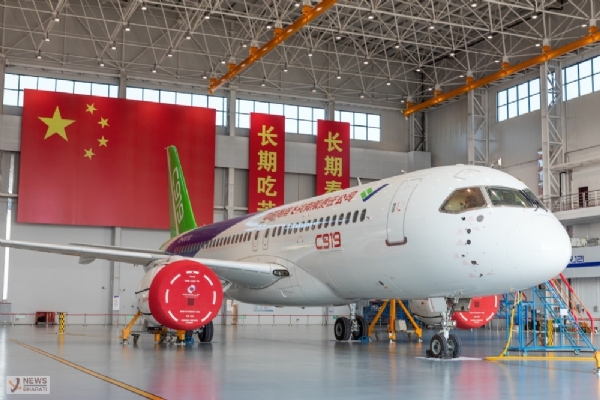China's Aatmanirbhar Aircraft mission with C919
On the contrary to this, India’s most significant economic competitor China has launched its domestically produced aircraft called C919.
Total Views |
Recently, Tata-owned Air India made a historic deal with the world’s two of the largest aircraft manufacturers Airbus and Boeing to procure 470 aircrafts worth Rs. 4.6 lakh crores. This deal has attracted a positive response from the western world, especially from political leaders. The US President Biden has hailed this deal as the “shining example of mutually beneficial cooperation” whereas the French President Macron has also appreciated this deal as this deal is expected to create thousands of jobs in Europe and the US. Thus, this deal is not only important for India’s domestic economy which has witnessed a surge in air travels in the post-pandemic period but also for India’s foreign relations as it also aids economic recovery efforts of western countries.

On the contrary to this, India’s most significant economic competitor China has launched its domestically produced aircraft called C919. It is a narrow-body passenger jet developed by Chinese State-Owned Enterprise (SOE) Commercial Aircraft Corporation of China (COMAC) and it is expected to be launched commercially within a year. It has been in the development stage since 2008 and being designed to compete with Boeing 737 and Airbus A320 which are regularly used for commercial civil aviation purposes across the world. Interestingly, out of 470 aircrafts ordered by Air India, 400 aircrafts belong to Boeing 737 and Airbus A320 that can carry between 158 to 192 passengers.
Also Read: China’s New Arabian Diplomacy
C919 made its first test flight in 2017 and finally received an airworthiness certificate to officially launch operations in September 2022. In fact, its first order has already been delivered to China Eastern Airlines in December 2022 at the cost US$ 99 million. However, it will further undergo several tests before it can be used for commercial operations. By the end of 2022, COMAC has received 305 orders for C919, significantly more than Boeing 737’s 116 orders during the same period. With the end of China’s zero-COVID policy, air travel is expected to return to pre-COVID levels soon which will increase the demand for more aircrafts owned by Chinese airlines. Thus, COMAC officials have even set the target to reach annual manufacturing capacity of 150 in the next five years which will enable it not only to meet domestic demand but to export C919 as well.
Competition with Boeing and Airbus
Many experts in aviation field expect that C919 has the potential to break the duopoly of Boeing and Airbus in the global market, albeit its heavy reliance on foreign parts. COMAC has several advantages over its western counterparts such as strong backing of state capital, huge domestic market and favourable government policies. Thus, it will not be difficult for COMAC to achieve a predetermined target of 10% domestic market share by 2025. Moreover, Boeing had become the victim of souring US-China relations as it was banned until January due to two fatal accidents in Indonesia and Ethiopia in the last few years. China’s efforts to promote C919 is a part of its larger plan to achieve self-reliance in technology by reducing dependency on western companies. However, many parts of C919 like engine, control systems, communication system and gears are still imported from western countries. A report published by an American think tank suggests that nearly 60% of all raw materials for C919 come from US companies. To exploit such high dependency, the US Commerce department has put several subsidiaries of Aviation Industry Corporation of China (AVIC) in a negative list with alleged military ties, under the pretext of China’s efforts to integrate civilian commercial research in military modernization. Majority of remaining raw material is supplied by European companies. Thus, it is expected that Chinese companies would find it more difficult to procure parts required to produce C919 aircrafts with growing tensions between US and China. Chinese SOE Aero Engine Corporation (another Chinese company sanctioned by the US) has been making efforts to produce indigenous engines to be used in C919. However, it is still years away from its commercial use as per the officials concerned with its manufacturing. Thus, C919 has to rely on an engine produced by a joint venture between the US and French companies, at least for the next few years.
Further, it will also be difficult for China to get certification from western aviation regulators regarding its operations with airlines owned by western businesses. It is evident from the past experience in the case of an ARJ21 jet, also produced by COMAC in 2015, which is still to be certified by the US Federal Aviation Administration and European Union Aviation Safety Agency. Thus, China will have to rely on other markets initially to gain acceptance for its indigenous aircraft at global level. Moreover, several aviation experts claim that recent accidents of Boeing 737 in Indonesia and Ethiopia has slowed down the certification system globally due to safety concerns. This is likely to affect C919’s certification even in non-European markets.
Thus, China and India’s efforts in the civil aviation industry, although may appear to be opposite to each other, but the underlying reliance on the west is still the common thread between them. China’s attempt to reduce external reliance, especially on western companies is clearly visible in several sectors including aircraft manufacturing. However, it will be difficult for China to challenge the duopoly created by Boeing and Airbus as both companies have deeply penetrated in global markets. Further, China’s indigenisation efforts are itself dependent on western suppliers for many inputs which is a crucial challenge for China. Here, India stands to gain as both western companies would look for alternative markets as they will have competition in the Chinese market from C919. Hence, as air travel continues to become affordable and accessible in India, this timely deal struck by Air India and similar talks by Indigo can help these Indian companies to grow rapidly and contribute more to India’s economic growth


